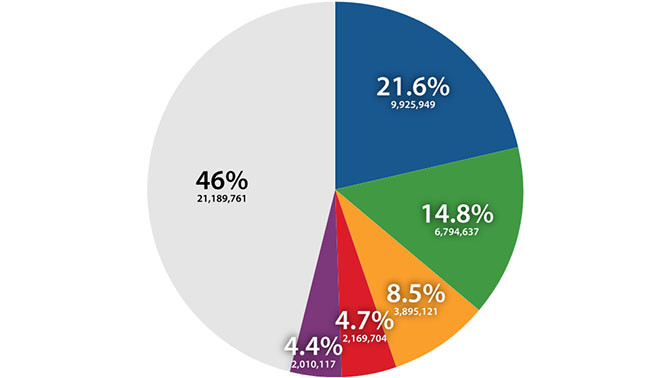Why do most Koreans have family Kim, Lee or Park?
Nearly half of the Korean population has a family name of Kim, Lee or Park. Why is that?
Koreans have a saying: if you drop a rock from the top of Namsan Mountain (located in Seoul), that stone will fall on a person with a Kim or Lee surname. According to Economist, one out of every 5 Koreans carries the family name Kim. Park's number of people is also very high, celebrities can be mentioned as President Park Geun-hye, singer Psy of Gangnam Style (Park Jae-sang's real name) or soccer player Park Ji-sung. About 1 in 10 Koreans have a family name of Park. In sum, the people of Kim and Lee, Park took up nearly half of the nation's population.

Kim, Lee are 2 of the 3 most popular families in Korea.
Other countries like China have more than 100 common families, while Japan has 280,000 different families. Why are the 3 families so popular in Korea?
It all originated in the feudal period. Koreans hardly carry them until the Korean kingdom (1392). Before that, only royal or noble people could bring them. The rest of the rest, including the merchant class, the boatmen or the monks, did not bring them.
By the 10th century, Cao Ly Thai To Vuong Kien began to introduce the rule of conferring them to reward loyalists and officials in the court. The Faculty system also begins to ask those who pass to bring them. Since then, the need to bring a family increased, especially in the rich or the merchant. The easiest way is to buy a place in the lineage of a lineage with a family name, even a fake name. In the opposite direction, many lineages without children can be sold in a genealogy position to an unknown person. Thus this person will carry a "noble" family.

The proportion of them in the Korean population: Kim (blue), Lee (green), Park (orange), Choi (red), Jung / Chung (purple).
Since ancient times, the Lee and Kim families have been the surname of the Korean royal family, so the nobles later chose either of these two families, and then the buyers of them also followed. Due to this boom, Koreans introduced the concept of indigenous (bongwan) , ie, apart from them, one is known by their bongwan. For example, Kim has about 300 origins, including Kim Gyeongju or Kim Gimhae. Prince Ly Long Tuong of Vietnam after fleeing to Cao Ly in the 13th century also created the Ly Hoa Son family (Lee Hwasan).
Because there are so many people with them, it is sometimes difficult to determine if two people are related. At the end of the Korean period, there was a rule that people with bongwan were not allowed to marry. At the end of Korea (1894), the Korean class system was abolished, and ordinary people could also choose for themselves. These people often choose common families, namely Kim, Lee and Park.
Today, the Kim, Lee and Park families are still growing in numbers, as most foreigners after their naturalization choose their surname, Kim, Lee, Park and Choi, according to Korean government figures. .
- Why do we 'grow as fast as we blow'?
- Meet the Bigfoot monster family in the American National Park?
- Koreans flocked to hunt for falling meteors
- Nhan successfully cultivated 3 rare and precious butterflies at Cat Ba National Park
- Explore the world's first underground park
- Ho Chi Minh City is about to have Science Park more than VND 4,260 billion
- Huge butterfly
- The secret dish of the world's longest-lived family
- Cuba operates the second solar park
- Cyworld - the virtual society of Koreans
- Discover a new species in Lam Dong
- Hanoi is about to have the Thien Van Park outdoors
 'Fine laughs' - Scary and painful torture in ancient times
'Fine laughs' - Scary and painful torture in ancient times The sequence of numbers 142857 of the Egyptian pyramids is known as the strangest number in the world - Why?
The sequence of numbers 142857 of the Egyptian pyramids is known as the strangest number in the world - Why? History of the iron
History of the iron What is alum?
What is alum?